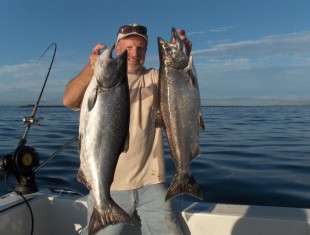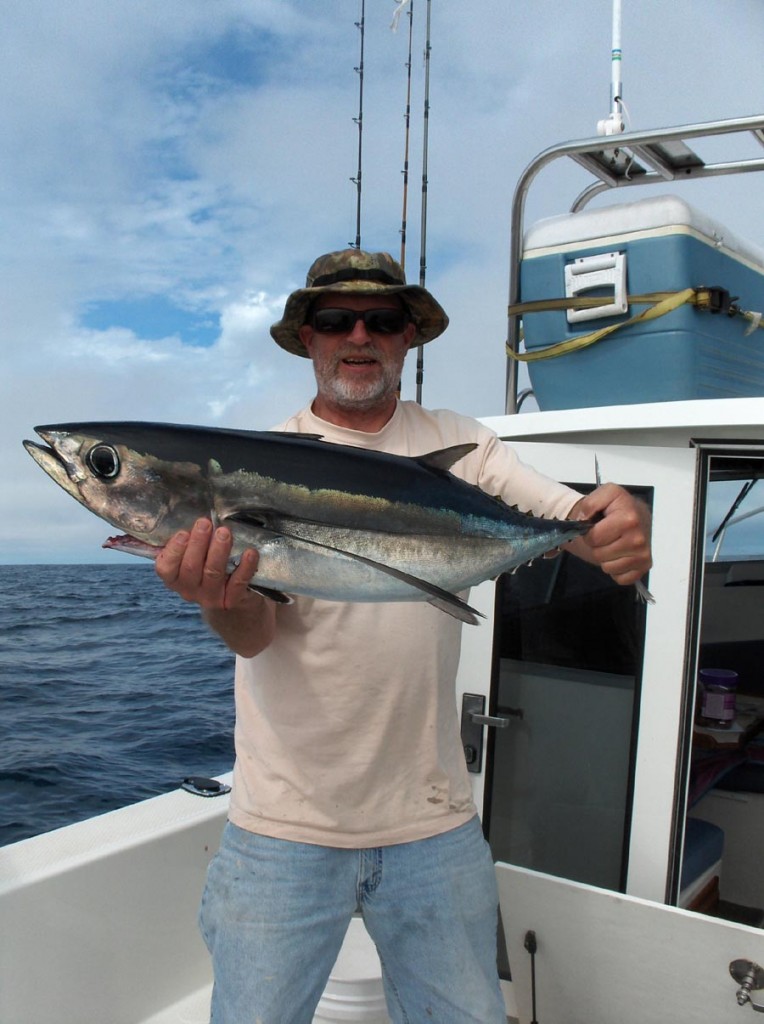Earl Sande with two kings
I try to take at least one tuna trip out of Westport every summer. I am lucky enough to have two good friends that have the boats and more then enough fishing experience to make this happen.
Having worked over the last 40 years on engines and outdrives makes me kind of handy to have around. I’m happy to spend the time and energy helping to maintain these two boats so we don’t have mechanical problems while fishing in the ocean.
Tim Zech called me the second week of August and said he had time to go tuna fishing the very next week. That sounded good to me.
Our other two crew members are Tim’s son Taylor and Dave Daniels
We kept a close eye on the NOAA weather site and picked Friday for our 40-mile trek across the ocean water to the tuna grounds. The weather forecast wasn’t perfect with eight to 10-knot winds from the south with a three-foot swell and one to three-foot wind waves.
I’ve been tuna fishing with no wind and glassy smooth water, but that’s a rare exception. Glassy smooth water makes it easier to see the bait and tuna jumping hundreds of yards away. When the water is choppy it’s harder to see tuna jumping, so we look for birds that are feeding off in the distance and troll toward them. Some times that works and some times it doesn’t.
Last year was the first year we tried fishing with live anchovies. A lot of sport boats are doing that now. This method of tuna fishing works very well at times. You troll various kinds of tuna jigs 30 to 60 feet behind the boat with hand lines and poles while running about eight miles per hour until two or three tuna get hooked up.
Then slow down or stop the boat and start throwing live and dead anchovies over the side to hold the tuna school near the boat. Then get the tuna in but leave one out there.
While all this is going on, we start putting live bait on a little tuna hook and let it swim away from the boat. When a tuna grabs it and takes off you count to five and give your rod a little tug.
The fight is on.
Sometimes you can catch five to 30 tuna at one bait stop. By that time the blue sharks usually show up and scare all the tuna away plus eat all your anchovies, and then it’s time to move on!
Tim’s boat had been at the dock for three weeks so he could go fishing every chance he could. He took some friends out the weekend before and caught four nice kings to 34 pounds one day plus four hatchery silvers.
The engine was ready for an oil change and the fuel tank was low so we decided to leave Belfair at noon then fish for salmon just south of the sunken jetty after we got our chores with the boat done.
We were trolling flashers and spoons by 5 p.m. Thirty seconds after Dave got his line out he had a fish on. Five minutes later we had a 20-pound king in the box!
By 7:30 p.m. we had four nice Chinook and two hatchery silvers in the icebox. We also lost four nice Chinook for various unknown reasons.
We headed back for a big barbequed rib dinner at the dock.
At daylight we were at the bait dock picking up a $100 worth of live anchovies for our live tank and headed out of the famous Westport harbor with no wind blowing. Before long we were heading west at 24 miles per hour toward the blue water.
We started seeing a few tuna jumping out of the water when we were about 40 miles from shore. We slowed down to about eight miles per hour and put out four poles and four hand lines.
The NOAA weather forecast was right on. The farther out you go the more wind you get. It wasn’t bad, but like I said glassy smooth is more fun.
Another thing we talked about was how the tuna fishing is after a big wind. So many times in the past for some unknown reason we have noticed a lot of the tuna stay deep for three to four days after a big wind, but during the day of a big wind they usually act normal.
Anyway, Wednesday the wind blew 25 knots out of the south. Most guys on the radio were saying fishing was a little slow. But we did talk to one boat that had caught 30 tuna during one bait stop, until the sharks came and messed things up.
Earl Sande with a tuna
It took about 20 minutes to catch tuna number one. Then another and another. Then we got two on. This was live anchovy time!
When the boat slowed to a stop, I hooked on a live anchovy and started letting line out. About 20 feet from the boat a tuna took the bait and the line was ripping off the reel. I counted to five and set the hook.
There was no stopping this fish for at least 50 yards. Then he swam to the boat, but quickly went straight down 50 yards three different times. Finally I got him close enough for one of the guys to gaff the 20-pound tuna.
Into the fish box he went.
Unfortunately that was the only real chance to use our live bait. The rest of the day was slow fishing. We just picked one up here and there.
By four in the afternoon we had 17 tuna on board and we headed back to the harbor at 25 miles per hour, cruising comfortably with the waves.
Last year we came home with 44 tuna, but 17 was probably better then a lot guys did that day. They are probably killing them again this week.
We all ended up with a five-bucket full of prime tuna fillets. Fresh fried albacore tuna steaks are some of the best eating fish in the world.
Get out and get some while the getting is good!


